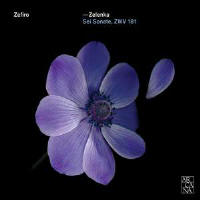Texte paru dans: / Appeared in:
|
|
|
Reviewer:
Ronald E. Grames Actually, the cover just says Zefiro, but when these recordings of the highly inventive trio sonatas of Czech composer Jan Dismas Zelenka (1679–1745) were first released on the Astrée Auvidis label in 1993 and 1995, it was Ensemble Zefiro. The two single-CD releases were appreciatively reviewed by John Bauman, Fanfare’s resident Zelenka guru at that time, in issues 17:5 and 19:4, where he declared that this and the earlier period-instrument release on Accent—I believe the first such recording of all six sonatas—were the sets to have. The Zefiro accounts have been out of the catalog for what seems like forever. Finally the two-disc set has been licensed from Naïve, which now owns the recordings, and reissued on the Arcana label as part of a very attractive series of the ensemble’s recordings. The Accent set is now available on Glossa, but I must admit that I am less enamored of the rather four-square approach of Paul Dombrecht, Marcel Ponseele, and Danny Bond than was Bauman. But regarding this set now on Arcana, there hasn’t been much in the intervening years to challenge that recommendation. In truth, though, there really haven’t been any bad recordings of the six trio sonatas since the first one was released on Archiv in 1973. This is a surprise, as they are technically quite challenging for the three soloists: two oboists and bassoonist in all but number three, and the violinist for one of the oboists in three. But consider the artists who have assayed them, beginning with Heinz Holliger, Maurice Bourgue, and Klaus Thunemann in the pioneering recording, and in a remake in 1999 for ECM: virtuosos, all. Zeriro is no exception, boasting artists who have made a huge splash in the Italian wing of period-instrument field: Alfredo Bernardini and Paolo Grazzi, and bassoonist Alberto Grazzi. Manfredo Kraemer takes the violin part in the Third Sonata. Zefiro took full advantage of the depth of their roster at that time, and of the composer’s laissez-faire approach to instrumentation in the basso continuo. So, Rinaldo Alessandrini (!) alternates between harpsichord and organ. Theorbo player Rolf Lislevand performs, as does Lorenz Duftschmid on violone, Zelenka’s own instrument. The result is a markedly rich sonority behind the perfect blend of light, sweet-toned oboes and the slightly stuffy tone of the Baroque bassoon. By contrast, most modern-instrument recordings, including that first one on Archiv, use only harpsichord and double bass. Those were the composer’s nominal choices—where basso parts have come down to us—and are perfectly acceptable, if less compelling. For those who cannot abide period instruments performances—for whatever reason beyond my understanding—that is the alternative. For years, I have preferred either of Holliger’s recordings for modern sonorities. Recently, I have been made to reconsider by the outstanding releases on the Crystal label with Erin Hannigan and Kathryn Greenbank, oboes, and Benjamin Kamins, bassoon. If I were going for a modern-instrument performance, theirs would be it, and as a bonus I’d have their arrangement of Sonata Number 3 for two oboes, in addition to the canonical version for oboe and violin, and harpsichordist Layton James’s exemplary notes.
Still, for me, if I could have
only one set—unthinkable—it would be this one by Zefiro. Those who already
have the earlier releases need not reapply; the new mastering seems to have
refined the sound slightly, but the difference is not significant, and I
actually prefer the more detailed version of Alfredo Bernardini’s program
notes in the original issue. For those who do not yet own these
performances—and especially to those who have not yet become acquainted with
this cornerstone of the double-reed repertoire—this set is urgently
recommended.
| |
|
|
|
|
|
|
|
Cliquez l'un ou l'autre
bouton pour découvrir bien d'autres critiques de CD |
|




